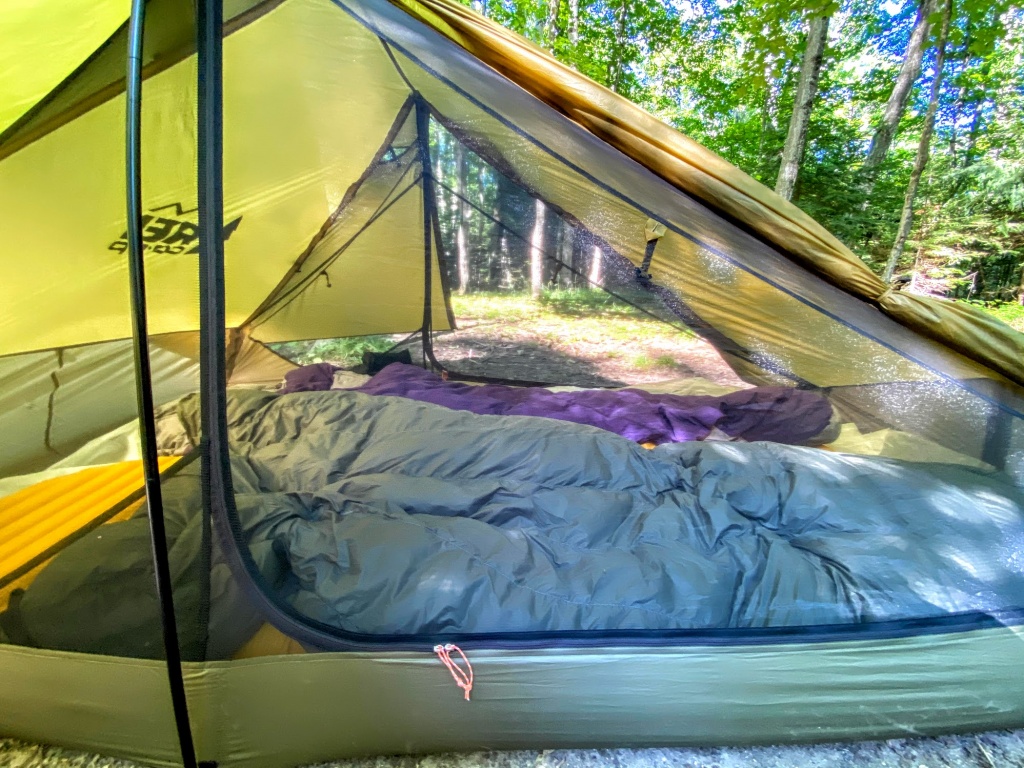REI Co-op Flash Air 2 Review
Our Verdict
Our Analysis and Test Results
This tent is about as light as they come before you start to transition into the world of tarps and other non-quite-a-tent shelters.
Performance Comparison
Comfort
This tent underperforms its dimensions on paper. With an 88" length and a 52" width, it seems like this model can hang with the best of them. However, floor space is only one part of the equation. Even with a peak height of a respectable 42", the interior volume is still severely lacking. The gently sloping ceiling, narrow peak height plane, and heavy taper at the foot all combine to create a somewhat claustrophobic interior. We found that it is not particularly enjoyable for two people to be sitting up at the same time.
We do appreciate that there are two side doors. However, the poles occupy a space right outside of the tent such that the size of those doors has to be considerably smaller and slightly unconventionally located than a typical 2P. The two side storage pockets also just whisper their existence.
Weather Resistance
Though it is perfectly adequate for light to moderate rain, the Flash Air will struggle in severe weather unless it is really well guyed out. The shallow ceiling can sag in a downpour. We also struggle with how close to the ground the door runs. There is very little 'lip' like you might see on a more traditional double-wall tent; the door zipper all but touches the ground, leaving the tent susceptible to moisture and debris.
One feature worth noting is that it is a single wall tent. That is, the fly is attached to the tent body and there is no mesh ceiling. The benefit of this is that the fly is permanently attached; if you get to camp in the rain, the inside of your tent is protected as you set up. The downside is that the fly is permanently attached; there are two tiny fly vents, but most of the meaningful airflow is going to come from tying back the fly doors.
Ease of Setup
If you haven't pitched a non-freestanding shelter before, there is a steep learning curve for this model. It comes with three poles — two identical side poles for support over the doors, and one single-segment pole to expand volume at the foot. You have to start by staking out the tent, and then moving on to poles (either the included set or trekking poles). If you are going to encounter inclement weather, we recommend using the additional guyline to firm up the structure.
One of the primary drawbacks of a model like this is that it requires the right kind of site selection. The setup has to be just right for staking — even one loose corner will lead to a minor collapse. The other consideration is that even though the floor dimensions of the tent are perfectly average, the guyline to stake out the corners requires quite a bit more additional ground space, meaning that the total footprint for pitching is notably larger than the actual footprint of the tent.
Durability
This super lightweight tent comes at the expense of durability. The thin ripstop nylon floor and fly both require reasonable care. The fly and tent door zippers are also more delicate.
It won't stand up to abuse the same way that a 68D polyester tent would, but it is notably thicker nylon than other models in the 2-pound range, making it one of the more durable ultralights.
Weight and Packed Size
Of course, all of the knocks against this tent outlined above are design sacrifices made so that it can weigh as little as possible. Coming in at two pounds, eight ounces, it is, indeed, a very lightweight tent. If you opt to leave the included poles behind and use a pair of trekking poles, the weight drops to two pounds, two ounces.
Unsurprisingly, the Flash Air also packs down extremely well. The entire thing can easily be carried by one person with plenty of room to spare in a 60L pack, especially if you leave the poles behind.
Value
As far as value is concerned, we think that it is quite good. We have outlined how this tent falls short, but its shortcomings are not especially unique to this specific model; it is more a function of the style of a single wall, non-freestanding tent. With that in mind, it comes in at a relatively reasonable price point and offers enough durability that the value is there in the long run.
Conclusion
The REI Flash Air 2 is meant for the hiker that isn't quite ready to go full tarp but still wants to minimize weight as much as possible. We think if you have already made the choice to prioritize weight savings above all else, this model should remain in contention.














